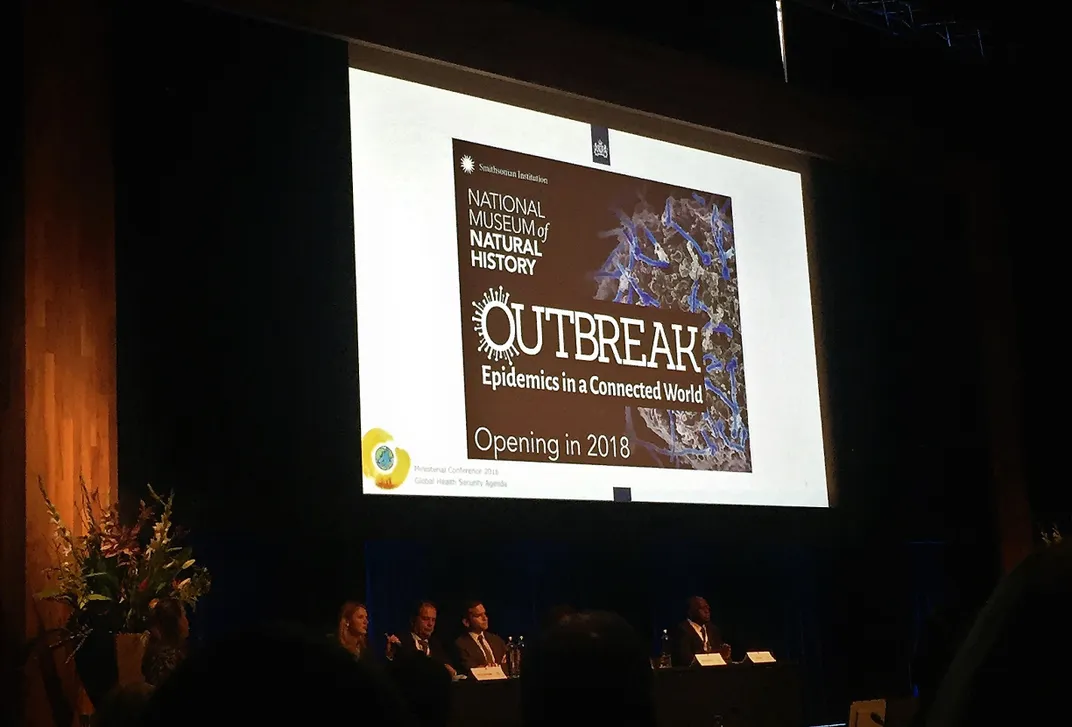NATIONAL MUSEUM OF NATURAL HISTORY
New Smithsonian Exhibit Spotlights “One Health” to Reduce Pandemic Risks
Sabrina Sholts, Curator of Physical Anthropology discusses her work on “Outbreak,” an upcoming exhibit at the Smithsonian’s National Museum of Natural History that aims to raise public awareness about pandemic risks in order to decrease them.
/https://tf-cmsv2-smithsonianmag-media.s3.amazonaws.com/blogging/featured/SV_Outbreak_sign.jpg)
Pandemic risks. Emerging threats. Global health security.
Four years ago, such terms were not part of my regular vocabulary. They appeared in articles that I read, but none that I wrote (keywords: craniometrics, forensic anthropology, 3D laser scanning). I was the newest Curator of Physical Anthropology at the Smithsonian’s National Museum of Natural History (NMNH), where I was eager to focus on research about environmental contaminants in the past and present. In this work, I saw my best opportunities to increase knowledge about human health today.
Then I began to see more. That year, an outbreak of an Ebola virus in West Africa became the largest in history. The virus wasn’t new and neither were the traditional funerary practices that created socio-cultural pathways for its transmission. What had changed was the ecological context: an increasingly connected and human-dominated world. Following its “spillover” from a wild animal in rural Guinea, the virus spread along road networks from villages that were no longer isolated. Across porous national borders and into the highly populated capital cities of Sierra Leone and Liberia (and reaching Nigeria and other countries via infected air travelers), its geographic span was unprecedented. Community education and behavior change were critical to stopping new infections, thus helping to end an epidemic that claimed more than 11,000 lives.
This is one story and a consistent theme in Outbreak: Epidemics in a Connected World, an upcoming exhibit at NMNH that started during the 2013-16 Ebola virus epidemic and opens May 18 during the centenary of the 1918-19 influenza pandemic. The catalyst was Dr. Daniel Lucey, an infectious disease physician who travels to the front lines of outbreaks to treat patients and prevent new infections. His idea for an exhibit about zoonoses - diseases caused by pathogens that are transmitted to humans by domestic animals and wildlife, such as Ebola virus, Zika virus, HIV, and influenza - was thrilling to me. As the Lead Curator of Outbreak, I worked closely with Dr. Lucey and Dr. Jonathan Epstein, a veterinary disease ecologist who goes to places where these pathogens emerge and identifies their animal hosts. Together with a phenomenal team of exhibit and education specialists at NMNH, we produced content that was consistent with the goals and messages that we prioritized.
The main goal of Outbreak is to raise public awareness about pandemic risks in order to decrease them. Zoonoses with a wildlife origin are a significant threat to global health, but many people are uninformed about how and why outbreaks of these diseases are becoming more frequent. We explain how human activities (such as urbanization, industrialized food production, global travel and animal trade) increase opportunities for zoonotic infections and why human behaviors (such as touching wild animals, traveling when sick, non-vaccination, unprotected sex) can help them spread. Presenting these diseases in the broadest ecological context, the main message of Outbreak is that human, animal, and environmental health are all connected as “One Health”.
The impact of Outbreak on the general public remains to be seen, but already for me it’s been huge. I’ve presented this work at a high level meeting of the Global Health Security Agenda (GHSA) in Rotterdam, the International Meeting on Emerging Diseases and Surveillance in Vienna, the Prince Mahidol Award Conference in Bangkok, and The Next Pandemic symposium in Washington, DC, building an incredible network of collaborators and supporters whom I would not have met otherwise. My research is expanding to study microbial factors of health and investigate ancient pathogens using NMNH collections. I produce articles in medical journals as well as anthropological ones (keywords: pan-epidemics, One Health, planetary health). Most importantly, I see tremendous potential to contribute more to our understanding of human health as inseparable from the ecosystems within and around us – and upon which we as a species depend.


